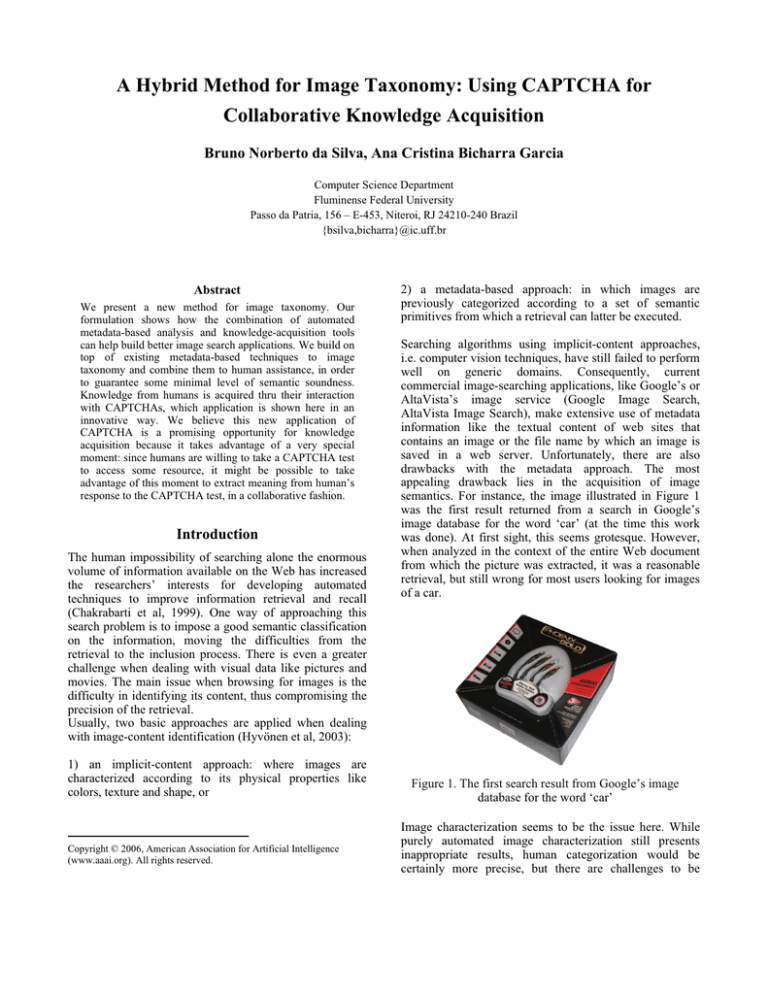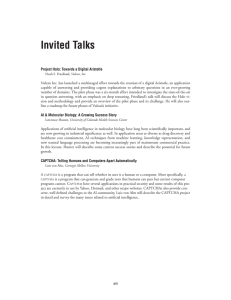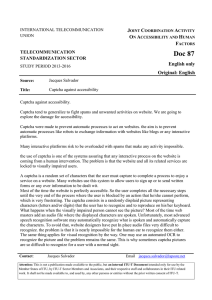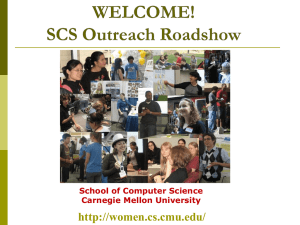
A Hybrid Method for Image Taxonomy: Using CAPTCHA for
Collaborative Knowledge Acquisition
Bruno Norberto da Silva, Ana Cristina Bicharra Garcia
Computer Science Department
Fluminense Federal University
Passo da Patria, 156 – E-453, Niteroi, RJ 24210-240 Brazil
{bsilva,bicharra}@ic.uff.br
Abstract
We present a new method for image taxonomy. Our
formulation shows how the combination of automated
metadata-based analysis and knowledge-acquisition tools
can help build better image search applications. We build on
top of existing metadata-based techniques to image
taxonomy and combine them to human assistance, in order
to guarantee some minimal level of semantic soundness.
Knowledge from humans is acquired thru their interaction
with CAPTCHAs, which application is shown here in an
innovative way. We believe this new application of
CAPTCHA is a promising opportunity for knowledge
acquisition because it takes advantage of a very special
moment: since humans are willing to take a CAPTCHA test
to access some resource, it might be possible to take
advantage of this moment to extract meaning from human’s
response to the CAPTCHA test, in a collaborative fashion.
Introduction
The human impossibility of searching alone the enormous
volume of information available on the Web has increased
the researchers’ interests for developing automated
techniques to improve information retrieval and recall
(Chakrabarti et al, 1999). One way of approaching this
search problem is to impose a good semantic classification
on the information, moving the difficulties from the
retrieval to the inclusion process. There is even a greater
challenge when dealing with visual data like pictures and
movies. The main issue when browsing for images is the
difficulty in identifying its content, thus compromising the
precision of the retrieval.
Usually, two basic approaches are applied when dealing
with image-content identification (Hyvönen et al, 2003):
1) an implicit-content approach: where images are
characterized according to its physical properties like
colors, texture and shape, or
Copyright © 2006, American Association for Artificial Intelligence
(www.aaai.org). All rights reserved.
2) a metadata-based approach: in which images are
previously categorized according to a set of semantic
primitives from which a retrieval can latter be executed.
Searching algorithms using implicit-content approaches,
i.e. computer vision techniques, have still failed to perform
well on generic domains. Consequently, current
commercial image-searching applications, like Google’s or
AltaVista’s image service (Google Image Search,
AltaVista Image Search), make extensive use of metadata
information like the textual content of web sites that
contains an image or the file name by which an image is
saved in a web server. Unfortunately, there are also
drawbacks with the metadata approach. The most
appealing drawback lies in the acquisition of image
semantics. For instance, the image illustrated in Figure 1
was the first result returned from a search in Google’s
image database for the word ‘car’ (at the time this work
was done). At first sight, this seems grotesque. However,
when analyzed in the context of the entire Web document
from which the picture was extracted, it was a reasonable
retrieval, but still wrong for most users looking for images
of a car.
Figure 1. The first search result from Google’s image
database for the word ‘car’
Image characterization seems to be the issue here. While
purely automated image characterization still presents
inappropriate results, human categorization would be
certainly more precise, but there are challenges to be
considered in this latter scenario: 1) the incentive that must
be introduced to people to spend their time describing what
they see in images, 2) the number of people that must be
involved to accept a categorization and 3) how to reconcile
the differences among multiple conflicting categorization
for the same image.
In other words, we need:
• some sort of reward (monetary, psychological, or
of any other kind) in compensation for the
cognitive effort exerted by humans,
• an environment that is accessible to a wide range
of people, in order not to make the knowledge
captured (too) biased, and
• tolerance to discrepancies, since people with
diverse backgrounds are expected to have
different views of the same objects. Different
descriptions for the same image not only must be
expected, but should be encouraged.
A successful instance of a human-assisted image content
identification can be found in (von Ahn and Dabbish,
2004), in which a framework is presented in the form of an
entertainment game that attempts to incentive people to
provide textual descriptions to images (Figure 2). In this
game, two players are paired anonymously and are asked
to type whatever they guess their anonymous partner is
typing. The only thing they have in common is that the
game presents both players with the same image.
Whenever the two partners agree on a label, they raise their
score and are faced with another image. Since they have no
communication with their partners, the only reasonable
strategy available for agreeing on a label is to provide
something related to the image shown, and thus the
submitted label might be a good description of the image
presented.
Figure 2. The ESP Game. A semi-automatic knowledge
acquisition method is applied in the form of an
entertainment game. Users are anonymously paired and
encouraged to provide textual descriptions to images. If
partners agree on a guess, their score is raised and the
common description is saved as a description to the
image.
While this approach provides sufficient rewards to achieve
a large volume of human participation (the entertainment
of the game experience) and supports conflicting
descriptions for the same image, there are drawbacks
associated with the use of entertainment as a means to
incentive human participation, namely the fact that
entertainment hardly ever attracts participation of people of
diverse nature or with different backgrounds (which might
make the acquired knowledge too biased and thus
inappropriate for various domains), the need of protection
against cheating of various kinds, among others.
In this paper, we present a hybrid method for building
image taxonomy that improves image retrieval based on
human assistance. Our method differs from previous
approaches by integrating metadata-based image search
techniques (Smith and Chang, 1997) with CAPTCHA’s
(von Ahn et al, 2004) model of interaction as an interface
with human knowledge. This way, we expect to gather the
advantages of both approaches: by allowing for automated
ways of collecting information, we make the information
acquisition process fast and reasonably efficient, and by
incorporating human participation, we refine our
knowledge base guaranteeing some level of semantic
soundness.
Our method can be described in two phases. In the first
stage, an automated search procedure navigates through the
Web collecting random labels. Then, an image repository
(like AltaVista Image Search) is queried using the
previously colleted labels. This search result will be used
as the raw material for our CAPTCHA construction.
Whenever a user tries to reach a page protected by our
CAPTCHA, one label from our database is displayed and a
random subset of images initially associated with the label
is selected to generate a CAPTCHA test.
If the test-taker passes the test, the submitted answer is
examined for the extraction of additional semantics to be
added to our image ontology. If the CAPTCHA is carefully
designed, this new information imbedded in the test’s
answer could be informative of the content of images
present in the ontology.
It is worthy to note that the use of CAPTCHA presents an
enormous opportunity for human-assisted knowledge
acquisition because
• the incentive for inducing human participation is
implied in CAPTCHA’s very nature. Since
CAPTCHAs are employed to protect some
resource, one can reasonably assume that the
agent trying to access the functionality is willing
to take to test. And by combining CAPTCHAs
with collaborative knowledge acquisition, we
make use of a very special moment when
designer’s interests (who want to acquire
knowledge) and user’s interests (who want to
access some resource) are directly aligned,
• since CAPTCHA’s use has found applications all
over the Web, the range of people that currently
take CAPTCHA tests are enormous, thus enabling
•
any CAPTCHA-based technology to have a large
potential audience,
and, since CAPTCHA’s definition presents no
restriction on the nature of the test being applied,
the test can be designed in order to achieve any
desired knowledge acquisition.
In the next Session, we review the CAPTCHA concept,
present the modeling of our ontology and describe our
method of ontology-building for image retrieval with
CAPTCHAs. Session 3 will contain a description of the
experiments performed to validate our proposal. A general
discussion is made in Session 4 and conclusions and
directions for future works are presented in Session 5.
CAPTCHA, Ontology and Collaborative
Knowledge Acquisition
CAPTCHA
CAPTCHA stands for Completely Automated Public
Turing Test to Tell Computers and Humans Apart (von
Ahn et al, 2004). It is an application that generates and
grades tests that attempt to distinguish humans from
computers. A CAPTCHA working procedure consists on
the generation and submission of a test to some agent and
the later evaluation of a received response. The agent’s
capacity of accurately solving the test should be indicative
of its nature: whether this agent is either a human or a
computational agent. In other words, a CAPTCHA test
should pose little or no problem for a human to solve it, but
must be impossible for current computers to pass. It has
been successfully adopted in a wide range of applications
running on the Web, from email accounts management
(Yahoo! Mail) to SMS message sending (Oi Internet).
One special CAPTCHA instance named Pix (Figure 3) is
of special interest to us.
Pix (The CAPTCHA Project) maintains a large collection
of images, each associated with one or more textual labels.
A test is generated by selecting a label at random, picking
up four images related to that label, and then asking the
user to indicate, from a list of all existing labels, which one
relates to all four images.
In this CAPTCHA, it is assumed that it is not possible for a
computer to identify a common aspect of all four images
and then find this feature in the list. The CAPTCHA we
have designed to demonstrate our method works roughly as
a reverse Pix, and will be presented in further details in
Session 3.
An implementation of Pix can be found in the CAPTCHA
project home page (The CAPTCHA Project), as well as
different instances of other CAPTCHAs.
An Ontology for Image Classification
In order to enable image classification, we model an
ontology to better assist the process of image classification.
Our modeling is deeply inspired by the semiotic relation
between signifier and signified proposed by Saussure
(Saussure, 1966). We initially consider two types of
objects, Images and Labels, and allow an association
between images and labels called Describes, which means
that the label is a good indicator of the image content.
As an example, were the image in Figure 4 present in our
ontology, one could reasonably expect associations with
labels such as heart and love. Unexpected associations
might include the labels war, car or bat.
Figure 4. Description for this image content could be
heart, love, among others.
With this relation alone, it is possible to provide a number
of functionalities for image searching. Additional relations
(binary, ternary, etc) could be inserted in the ontology to
enhance the expressive power of our method. We discuss
this possibility in Section 4.
Knowledge Acquisition with CAPTCHA
Figure 3. The Pix CAPTCHA. Pix maintains a collection
of images in its database, each associated with a set of
labels. For each test, Pix selects a label at random, selects 4
images associated with that label and includes them on the
test. The agent is asked to identify which label applies to
all 4 images.
Our method is constructed to work on top of image
searching services like those extensively applied over the
Web. It queries those services for label-image pairings and
then presents these pairings to humans to verify or
invalidate the association. In order to manage the
correctness of an association, we add a Confidence Rank to
each relation present in the ontology, meaning that the
higher an association’s Confidence Rank is, the more
certain the system is about that relation. The Confidence
Rank is updated indirectly by human indication, and we
extract this indication implicitly from the answer provided
by the CAPTCHA test taker. The more humans indicate an
association is pertinent, the higher the Confidence Rank of
a pairing will be. If the Confidence Rank is above a
Certainty threshold (Figure 5), the system will consider
that relation to be sound. If the Confidence Rank lies
between the Certainty threshold and a Suspicion threshold,
the association is suspected to be true but is yet to be
confirmed with human assistance. If the Confidence Rank
falls below the Suspicion threshold, the association is
considered to be false.
Figure 5. The Confidence Rank is used to manage the
correctness of an ontology association. The higher a
Confidence Rank is, the more likely a label correctly
describes an image.
Our method of knowledge acquisition is based on two
independent procedures which we call a Search Step and a
Resolve Step. The Search Step is responsible for retrieving
data from the Web and feeding it into the ontology. The
Resolve Step refines the association captured by the Search
Step by checking their correctness with human users. Both
steps are described in depth below.
The Search Step. The Search Step procedure is performed
as in the sequence-diagram depicted in Figure 6. A
Searching-agent starts browsing the Web looking for
random words, which can be acquired from any Web
service.
Later, an image searching service is queried with the
vocabulary acquired from the previous stage. Finally, for
each query executed in the image search, a pairing between
the string queried and each image returned is forwarded to
an Ontology-building agent as a Describes association.
This association means that the label is supposed to be
representative of the image content. Before inserting the
new objects and associations in the ontology, the
Ontology-building agent marks each recently discovered
pairing with an initial Confidence Rank. This default
Confidence Rank value will depend on the reputation of
the image-searching service used by the Searching agent.
Since current image searching services are not yet very
accurate, this value should indicate that further
verifications need to be applied to confirm the soundness
of the relation (i.e. the initial Confidence Rank lies
between the Suspicion threshold and the Certainty
threshold).
Figure 6. The Search Step sequence diagram. The
procedure begins by a Searching Agent retrieving random
words from Web services. With the returned vocabulary, a
search is executed on image-search directories, like
Google’s image database. For each query executed in the
search, a pairing between the string queried and each
image returned is added to the ontology as a describes
association
The Resolve Step. The Resolve Step aims at detecting
faults and discovering new associations between the
elements already present in the ontology, as indicated in
the sequence-diagram from Figure 7.
Figure 7. The Resolve Step sequence diagram. A
CAPTCHA agent retrieves a textual label and a set of
images from the ontology to generate a CAPTCHA test.
The test is submitted to the user, who replies with a
response to the test. The CAPCHA agent analyses the
response to extract additional semantics and add/update
information on the ontology.
The CAPTCHA-agent retrieves from the Ontologybuilding agent a textual label and a set of images, some
that the agents are certain to relate to the textual label (i.e.
the Confidence Rank of the relation is above the Certainty
threshold), some that the agents are certain not to relate to
the label (whose Confidence Rank falls below the
Suspicion threshold) and some which relation to the label
is yet to be attested (the Confidence Rank lies between the
Certainty and Suspicion thresholds). These data will be
grouped to form a CAPTCHA to be submitted to an enduser. Finally, depending on the CAPTCHA response, the
Confidence Rank of each relation involved in this iteration
can be increased or decreased, sharpening the correctness
of the ontology.
In Figure 8, we show an instance of a CAPTCHA
generated by the CAPTCHA-agent. It works roughly as a
reverse Pix and receives as input a label and a collection of
images, some related to the label, some that are not related
to the label and some which relation is to be verified. The
end-user is presented the label and the images formatted in
columns. All but one column contain only images whose
semantic relation to the current label is known a priori by
the CAPTCHA agent (whether the image relates to the
label or not).
the user with an option to indicate that no options apply in
any given column. This sets the stage for us to design
regular columns (not an experimental one) where the
correct answer will be this outside option (no options
apply), where all images in the column will not relate to
the selected label. This is to avoid any chance for the user
to distinguish the experimental column from a regular one.
When reviewing the correctness of the user’s response to
the test, all columns, except the experimental one, will be
taken into account. If the user has identified correctly all
associations in the regular columns, the CAPTCHA agent
will consider the response acceptable, will assume that the
experimental column selection is also correct and inform
the Ontology-building agent of the user’s response. With
this new information, the Ontology-building agent can now
update the Confidence Rank of all images presented in the
experimental column. The one image that was selected by
the user (if any) will have its Confidence Rank related to
the current label increased, while the others’ will suffer a
decrease.
It is important to stress that relations whose Confidence
Rank falls below the Suspicion threshold are just as useful
in the generation of this CAPTCHA as those whose
Confidence Rank reaches above the Certainty threshold. In
each column, ideally at most one image should relate to the
selected label, in order to protect against random-strategy
attacks from computer agents. All regular columns are then
formed by no more than one certain relation and a group of
certain negative relations.
Random attacks from computational agents could be made
less successful by generating tests with more columns or
more images per columns. This way, the probability of
passing the test using random responses would quickly
drop to any acceptable level.
Experiments
Figure 8. A CAPTCHA generated by the CAPTCHA
agent. The user is requested to identify in every column
which image relates to the label on the left, but is left
unaware that the last column is an experimental column, of
which content the CAPTCHA agent is not so sure about.
The image selected by the agent in this column will be the
source of knowledge acquisition from this test.
One special column, called the experimental column, is the
source of knowledge acquisition from the CAPTCHA
response. In this column, the CAPTCHA agent inserts
those images whose semantic still remains to be verified.
The user is then asked to identify, in each column
separately, which one image relates to the label presented.
Of course, since the CAPTCHA agent must support the
generation of a test that certainly has at least one correct
answer, and since he has no guarantee that the
experimental column will indeed have any image that
relates to the current label, the agent is forced to present
In order to evaluate the performance of our method, we
implemented a version of the model. A database of images
and labels was generated by collecting 600 images from
AltaVista’s image database (AltaVista Image Search), each
associated with a random label (totaling 30 different labels
in our database). We asked 10 volunteers to repeatedly take
a CAPTCHA test. All of them were Computer Science
graduates from the Fluminense Federal University, in
Brazil, between 23 and 28 years old. The CAPTCHA was
made available over the Internet for free use.
We assigned the values of 1 to the Suspicion threshold and
9 to the Certainty threshold. Whenever in the experimental
column, each indication from users that an image relates to
a label added 2 units to the Confidence Rank of the
relation, while a lack of indication from a test’s response
subtracted 1 unit from the Confidence Rank. All relations
had an initial Confidence Rank of 4 units.
After a period of two weeks, we analyzed the data present
in the ontology and could identify original information
present in the ontology. The relations associated with the
image from Figure 9 are an example of a successful
acquisition of knowledge from our experiments. The
original label associated with this image was John Lennon.
After our experiments, we could observe that such image
had established relations with the labels Rock Star and
Beatles.
In order to provide richer semantic information about
objects, one might model an ontology with relations other
than the Describes relation we mentioned before. In the
general case, our CAPTCHA agent could select a random
relation from the ontology and create a test asking the users
to indicate how one could make some presented predicate
true using the data present in the database. Figure 10
contains an example of such scenario. Here, the user is
asked to identify an animal (X1) that is a predator of
another (X2). This approach easily generalizes to N-ary
relations, where users are asked to identify every parameter
in the relation. The parameters in this general case could be
of any type (not only images).
Figure 9. A successful instance of our knowledgeacquisition method. This image was initially associated
with the label John Lennon. After our experiments, we
could describe it with the labels Rock Star and Beatles.
One drawback identified in our experiments was the large
amount of time required for the method to acquire new
information. There is clearly a tradeoff between speed in
the knowledge acquisition process and confidence in the
acquired knowledge. We are still experimenting different
values of the Certainty and Suspicion thresholds, and
investigating their effect on the global behavior of our
method.
General Discussion
The opportunity raised by CAPTCHAs on cooperative
knowledge acquisition is significant. If the tests are
properly designed, one could induce users to cooperatively
supply required information since both part’s interests are
directly aligned: users want to pass the CAPTCHA to
access some service or perform some task, and the
CAPTCHA designer wants to acquire information to
enhance Web services.
This formulation is specially interesting because it softens
the bottleneck of relying on a single or small group of
humans to identify an image’s content, since now this
effort is equally distributed across all CAPTCHA’s users.
The administrator of a popular Web service could rapidly
grow the information present in her ontology the more
users visit her system and take the CAPTCHA test.
Unlike previous approaches to this problem (von Ahn and
Dabbish, 2004), we need not design additional incentives
or interactions apart from what previously existed with
CAPTCHA. Additionally, the incentive embedded in
CAPTCHA use is very diverse and general, something
which does not occur very easily with entertainment
games, which could entertain only very specific kinds of
people.
Figure 10. A CAPTCHA test for a binary relation. In this
test, users as asked to identify each parameter, from a
certain relation from the ontology, that makes the given
predicate true. This test easily generalizes to N-ary
relations.
Conclusions and Future Research
We presented a novel approach to the problem of
ontology-building for image retrieval. Our main
contribution is the combination of existing image-search
techniques like metadata-based analysis with knowledge
acquisition tools. We have also shown how CAPTCHAs
can be applied to serve as knowledge-acquisition assisters,
something that can be done with no additional cost in
current Web applications.
The knowledge present in our ontology could not only
serve as database for image searching tools, but also as
object of study for client modeling. Since the knowledge
present in the ontology reflects directly what humans have
informed to the system, system managers could experiment
client modeling techniques for better addressing his
business interests.
We are currently running additional experiments to
validate our model in more complex settings, where the
relations present in the ontology are not only simple binary
relations between labels and images, but more complex
ternary or N-ary relations between any combinations of
data types (strings, numbers, images, etc).
Another interesting direction for future work would be to
work on the design of a CAPTCHA test where users would
be able to provide our method with new relations between
the elements of the ontology. The need to control
vocabularies while still satisfying the CAPTCHA security
requirement is a problem we expect to attack in future
versions of this work.
References
von Ahn, L.; Blum, M.; Hopper, N.; Langford, J.: The
CAPTCHA Project: http://www.captcha.net
von Ahn, L.; Blum M.; Langford J. 2004. Telling Humans and
Computers Apart Automatically: How Lazy Cryptographers
do AI. Communications of the ACM 47 (2): 56-60
von Ahn, L.; Dabbish L.. 2004. Labeling Images with a
Computer Game. In Proceedings of the ACM SIGCHI
conference on Human factors in computing systems, 319-326.
AltaVista Image Search, www.altavista.com/image/default
Chakrabarti, S.; Dom B.; Gibson D.; Kleinberg J.; Kumar S.R;
Raghavan P.; Rajagopalan S.; Tomkins A.. 1999.
Hypersearching the Web. Scientific American 280 (6): 54-60
Google Image Search, http://images.google.com/
Hyvönen, E.; Saarela S.; Styrman A.; Viljanen K. 2003.
Ontology-Based Image Retrieval. In Proceedings of
WWW2003, Budapest, Hungary, Poster papers
Oi Internet, http://www.oi.com.br
Saussure, F. 1966. Course in General Linguistics. New
York, NY : McGraw-Hill Book Company.
Smith, J.; Chang S. 1997. Visually Searching the Web for
Content. IEEE MultiMedia 4 (3): 12-20
Yahoo! Mail, http://www.yahoo.com




